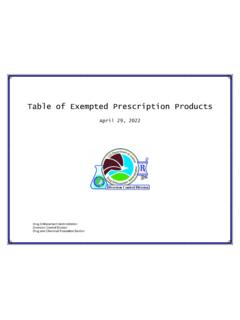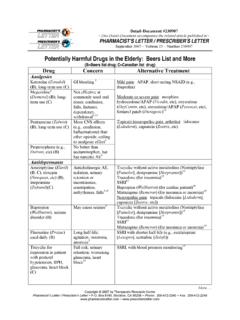Transcription of 1. Medications that Can Lead to a Dysphagia Side-Effect
1 Warning: This chart was created by , and it is intended to be used as a resource or guide for Speech- Language Pathologists and other healthcare professionals. This is not a complete list of all Medications that could cause Dysphagia , dry mouth and/or central nervous system changes. This information should not be used as a substitute for consultation with the appropriate healthcare professionals ( , the patient's doctor & pharmacist). 1. Medications that Can Lead to a Dysphagia Side-Effect Neuromuscular Blocking Agents / Direct effect on striated muscle Specific Drug Names: Also Known As: Common Uses: Atracurium Tracrium Muscle relaxation Cisatracurium Nimbex Muscle relaxation Doxacurium Nuromax Long-acting muscle relaxation Mivacurium Mivacron Short-acting muscle relaxation Pancuronium Pavulon Muscle relaxation Pipecuronium Arduan Muscle relaxation Rocuronium Zemuron Muscle relaxation Succinylcholine Anectine Muscle relaxation during surgery when using a ventilator; sometimes used during intubation Tubocurarine Tubarine Muscle relaxation Vecuronium Norcuron Muscle relaxation (generally given before anesthesia).
2 Antipsychotic / Major Tranquilizers / Neuroleptics Examples of Typical/ Also Known As: Common Uses: Conventional: Chloropromazine Thorazine Treat psychotic disorders including schizophrenia, manic-depression, or severe behavioral problems Haloperidol Haldol Treat schizophrenia and Tourette's syndrome (*per should not be used for psychotic conditions related to dementia). Examples of Atypical/ Also Known As: Common Uses: Novel: Clozapine Clozaril Treat schizophrenia Olanzapine Zyprexa Treat psychotic disorders including schizophrenia or bipolar disorder Risperidone Risperdal Treat schizophrenia, bipolar disorder Medications that can cause to Esophagitis / Esophageal Injury / GERD (con't). Drug Classes: Examples (brand names): Common Uses: Bisphosphonate Alendronate (Fosamax) Postmenopausal Etidronate osteoporosis, irregular Ibandronate (Boniva) bone growth Antibiotics Doxycycline Treat infections Akhtar (2003) Tetracycline Clinamycin Penicillin Erythromycin Ciproxfloxacin Lincomycin Bronchodilator Theophylline (Theo-24, Bronchodilator Theo-Dur, Norphyl, etc) (When using inhalers, rinse mouth with water Fluticasone/Salmeterol and spit out water to (Advair) prevent thrush/sores).
3 Medications that can cause to Esophagitis / Esophageal Injury / GERD (con't). Non-Steroidal Anti- Ibuprofen (Advil) Analgesic, Anti- Infammatory (NSAIDS) Aspirin inflammatory Naproxen (Aleve). Indomethacin (Indocin). Steroid (corticosteroid) Methylprednisolone Anti-inflammatory, (Medrol) immune suppressant Prednisone Anticholinergics Emepronium Bromide Treats overactive bladder (can cause esophageal ulcer). Quinidine Quinine or Quinidex Treats malaria, but also antiarrhythmias. Alprenolol Chloride/ Aptine Antihypertensive Minerals and others Potassium Chloride Ferrous Sulfate or succinate Ascorbic acid Factors that increase risk for Taken at bedtime Geriatrics at increased the medication to cause Taken without enough risk esophageal injury, stricture fluid Enlargement of Left and/or ulceration: Taken in supine Atrium compressing Stoschus & Allescher (1993) position or in bed esophagus Akhtar (2003) Large pill size Thoracic surgery Hx of cirrhosis & portal Hx of Esophageal hypertension motility disorders &.
4 Strictures Medications that can cause to Esophagitis / Esophageal Injury / GERD (con't). Drugs that can cause Drugs that can decrease Other items that can gastroesophageal reflux lower esophageal decrease lower (listed below): sphincter pressure esophageal sphincter (listed below): pressure (below): Bronchodilators Atropine (Atropar) Alcohol Antiangina meds Dopamine Fatty, fried foods (Nitroglycerin, Isosorbide mononitrate) Butylscopolamine - Hormones: spasmolytic, Cholecycstokinin anticholinergic (stimulates digestion of (Buscopan) fat and protein). Glucagon Progesterone Calcium Channel blocker Theophylline (Nifedinpine, Diltiazem) Chocolate Nitrates Anxiolytic (Alprazolam) Calcium Antagonists Mint 2. Medications that Can Lead to a Xerostomia / Dry Mouth Side-Effect : Anticholinergic with Antimuscarinic Effects & Antispasmodics (Inhibiting parasympathetic nervous system).
5 Specific Drug Names: Also Known As: Common Uses: Atropine Atropar Relief from gastrointestinal spasms; antidiarrheal;. treating colitis; spastic bladder; diverticulitis Benztropine mesylate Cogentin Treating Parkinson's Disease symptoms, including muscle spasms, stiffness, tremors, drooling hyoscyamine Cytospaz Treating stomach, bowel and bladder spasms Anticholinergics (con't): Also known as: Common Uses: Ipratropium Atrovent Relaxes muscles in airways Increases airflow to lungs Tiotropium Spiriva Treats asthma and COPD. Scopolamine (Antiemetic) Transderm-Scop Relieves nausea, vomiting and dizziness. Used to decrease secretion of fluids ( , saliva). Pirenzepine Gastrozepin Treats peptic ulcers, reduces gastric acid secretions, reduces muscle spasm. Tolterodine Detrol Urinary antispasmodic for overactive bladder hyoscyamine Levsin Reduces muscle spasms in digestive system, and can be used to dry and reduces secretions Diphenhydramine Benadryl Treats allergy, hay fever, cold symptoms, itching, rashes.
6 Can be used to treat insomnia. Oxybutynin Ditropan, Driptane Treats overactive bladder Emepronium Bromide Emepronium Bromide Treats overactive bladder More Medications with Potential Xerostomia Side-Effects Drug Classes: Examples (brand names): Common Uses: Angiotensin-converting Lisinopril (Zestril, Prinivil, Block the angiotensin enzyme (ACE) inhibitors Tensopril, Hipril) converting enzyme to Captopril (Capoten), reduce blood pressure. Enalapril (Vasotec, Serious Side-Effect : angio- Renitec) edema (swelling) - tongue? Antihypertensives Guanfacine (Tenex) Treat high blood pressure Clonidine (Catapres). Terazosin (Hytrin). Drug Classes (xerostomia) Examples: Common Uses: Antinauseant/Antiemetic Meclizine (Antivert) Prevention of nausea. Dyphenhydramine Note: Odansetron (Zofran). (Dramamine) is also used to prevent Scopolamine nausea/vomiting with potentially less dry mouth side-effects.
7 Antidiarrheal Loperamide Prevent diarrhea (ImmodiumAD). Diphenoxylate with Atropine (Lomotil). Antihistamines and Diphenhydramine Treat the symptoms of Decongestants (Benadryl), allergic reactions (hay Pseudoephedrine (Sudafed) fever, hives, itchiness). Fexofenadine (Allegra). Loratadine (Claritin). Cetirizine (Zyrtec). Diuretics Furosemide (Lasix) Increase the volume of urine to promote the excretion of salt and water from the kidneys/body. Used to treat heart failure & kidney disease. Antianxiety Alprazolam (Xanax) Treat anxiety Lorazepam (Ativan). Hydroxyzine (Atarax, Vistaril). Oxazepam (Serax). Diazepam (Valium). Selective Serotonin Citalopram (Celexa), Block serotonin from being Reuptake Inhibitors Fluoxetine (Prozac), re-absorbed to regulate, Proxetine (Paxil), mood; treat depression, Sertraline (Zoloft) stress, OCD, and anxiety Venlafaxine (Effexor).
8 Other Antidepressants Bupropion (Wellbutrin) Used to treat major Mirtazapine (Remeron) depressive disorder. Desyrel (Trazodone) Note: Remeron is used to boost appetite Drug Classes (xerostomia Examples: Common Uses: continued): Dopamine antagonists Metoclopramide (Reglan) Increases gastric emptying and intestinal motility;. Increases resting tone of LES. Note: also risk for extrapyramidal &. Parkinsonian symptoms, which could last 2-3. months. Half-life with healthy renal function: 5-6 hours. Antiparkinsonian 1. Levadopa with 1. Medication is converted (dry mouth Side-Effect Carbidopa (Sinemet) into dopamine in brain. will vary depending on 2. Dopamine Agonists: the sub-classes) Ropinirole (Requip) 2. Mimic action of Pramipexole (Mirapex) dopamine 3. Monoamine Oxidase B 3. Reduce the breakdown (MAO-B) Inhibitors of dopamine in brain.
9 Selegiline (Eldepryl) 4. Treats symptoms or side Rasagiline (Azilect) effects of other drugs. 4. Benztopine (Cogentin) Improves muscle control & reduces stiffness. Anticonvulsants/ Gabapentin (Neurontin) Used to help control Antiepileptic Pregabalin (Lyrica) seizures. Carbamazepine (Tegretol) Gabapentin also used for Lamotrigine (Lamictal) restless leg syndrome. Felbamate (Febatol) Gabapentin & Pregabalin Levetiracetam (Keppra) are used for shingles &. neuropathic pain. Typical or Haloperidol (Haldol) Treat schizophrenia. Conventional Chlorpromazine Control psychotic Antipsychotics/ (Thorazine) symptoms, sedate agitated 1st Generation Thiothixene (Navane) patients. Perphenazine (Trilifon). Fluphenazine (Permitil, Prolixin). Drug Classes (xerostomia) Examples: Common Uses: Atypical or Novel Lurasidone (Latuda) Used to manage Antipsychotics/ Olanzapine (Zyprexa) Schizophrenia.
10 2nd Generation Quetiapine (Seroquel) Block Dopamine receptors Clozapine Aripiprazole (Abilify) May be less likely to cause Risperidone adverse reactions, like Ziprasidone Extrapyramidal Symptoms (EPS). Opioids Oxycodone Treatment of severe pain, Hydromorphone (Dilaudid) when other treatments have Hydrocodone/APAP not been adequate. (Vicodin). Oxycodone/APAP. (Percocet). Fentanyl 3. Medications that Can Lead to CNS Depression ~ Confusion, Altered Mental Status (AMS), Drowsiness: Medications leading to Confusion/AMS/Drowsiness with increased risk for falls: Drug Classes: Examples (brand names): Common Uses: Sedative & Antiemetic Droperidol (Inapsine) Reduce nausea and Dyphenhydramine vomiting (Dramamine). Dimenhydrinate (Meclizine). Antiepileptic/Anticonvulsant Carbamazepine Prevent seizure, drugs (Tegretol) excessive neuronal Gabapentin (Neurontin) firing.


